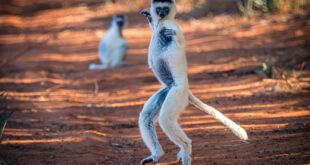Lemurs are generally considered social, peaceful animals. But one lemur, in particular, stands out in terms of its family ties: the eastern woolly lemur (Avahi laniger). The name comes from its slightly curly fur, which no other lemur in Madagascar has. Eastern woolly lemurs live only on Madagascar, they are endemic to the island. Their habitat is on the east coast of Madagascar – where there is still contiguous rainforest. Their range extends roughly from the Mangoro River at the level of the town of Antsirabe south of Antananarivo to the Bay of Antongil in the north with the adjacent Masoala National Park. Previously, it was thought that all woolly lemurs of the east coast belonged to the same species. In 2006, international researchers proved that they are five distinct species, namely Peyrieras, Ramanantsoavana, Betsileo, and Moore woolly lemurs. And, for sure, the real eastern woolly lemur.
Woolly lemurs are considered shy in Madagascar. They are said to have a rather secluded lifestyle. No wonder, because woolly lemurs are nocturnal. They spend the day sleeping far up in the tree, several of them huddled together in an inseparable ball of wool. Only in the darkness do they become active.
At the beginning of the dry season, between March and May, is mating season for the eastern woolly lemurs. The couples are usually fixed beforehand because these lemurs are very loyal and stay with their chosen partner for life. Each pair usually has only one young per year. It is born shortly before the onset of the rainy season, in August or September. The young animal clings to its mother’s fur and spends the first two months there. Only then it’s time for its first small excursions into the environment. It begins to take an interest in the food plants of its parents, initially through play, and to find out which fruits and leaves are edible and which are not.
At about six months, the young animal is weaned. Over the next few months, it learns how to move around in the treetops without falling down. It must also learn the social customs of the family. For eastern woolly lemurs, family is the most important thing in life. They spend nearly half the night grooming each other, interacting socially, or resting together. No one moves far away, and even while foraging, everyone stays close together at all times. Only parents and the last two born young are always together. Larger groups or mergers of several families do not exist in woolly lemurs.
At the age of one to two years young woolly lemurs become independent. Soon they go their own ways. Each family has a very small territory of only 0.01 to 0.02 km² – this seems little, but fits their site fidelity and their small body size. Adult eastern woolly lemurs do not even weigh one and a half kilograms.
The small lemurs are easy prey for Madagascar hawks during the day. Their biggest threat, however, is humans and habitat destruction. Currently, eastern woolly lemurs can still be found in the Andasibe-Mantadia National Park, the neighboring V.O.I.M.M.A. and Maromizaha protected areas, and the Akanin’ny Nofy Reserve, which is located a little further along the coast. There are still many families of eastern woolly lemurs on the move – but whether this will continue is uncertain.
 MADAMAGAZINE Your Magazine about Madagascar
MADAMAGAZINE Your Magazine about Madagascar




